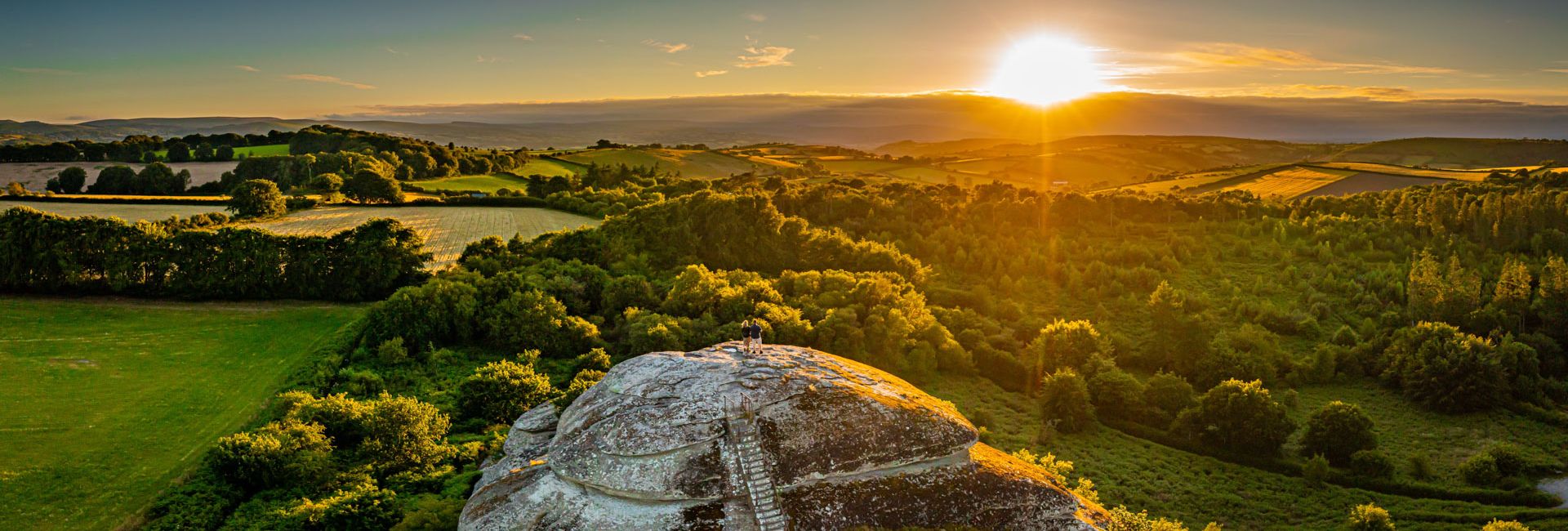Our picks for the top 5 Dartmoor tors
Dartmoor has one of the most spectacular landscapes in the country – and more than 160 tors from which you can see it at its finest. These hilltop granite outcrops all boast uniquely weathered rock formations and spectacular views guaranteed to keep you coming back for more. To get you started, here are five of our favourite Dartmoor tors, all within easy reach of our hotel.
Haytor
Stand atop Haytor with the wide skies stretching above you and miles of moorland unfolding below and you’ll see why it deserves its reputation as the most popular of all the Dartmoor tors. It has something for everyone – from grassy spots for family picnics to popular routes for climbers, who clamber up its granite rock formations. From the nearby car park and visitor centre, it’s a steady stroll up to Haytor Rocks, with their distinctive curves. From the top, you can see all the way to Teignmouth on the South Devon coast. Back in the 18th-century, granite from nearby Haytor Quarry – used to build the British Museum and Nelson’s Column in London – was transported to this port town via the Granite Railway, the tracks of which remain embedded in the landscape. Take a small detour to the nearby quarry, which is now a tranquil lake filled with water lilies and gently rusting machinery. The surrounding moorland attracts skylarks, meadow pipits, stonechats, wheatear and Dartford warblers. Also listen out for cuckoos in spring.
Hound Tor
Legends of ghostly dogs and horrifying hounds haunt the granite tips of Hound Tor. Its jagged rock formation is said to have been created when a witch cast a spell on a pack of dogs owned by a local hunter named Bowerman. But although it might have inspired Sir Arthur Conan Doyle’s savage beast in The Hound of the Baskervilles, today you’re more likely to come across an energetic Cockapoo or a friendly Golden Retriever as you explore the crags and crevices of one of our favourite Dartmoor tors. Or why not roll out your yoga mat and practise your downward dog on one of the many flat grassy areas in among the rocks? Before you leave, circle the stones to find the fascinating remains of a cluster of 13th-century stone long houses. This abandoned settlement is now home to an array of moss, lichens, ferns and wildflowers.
Rippon Tor
Rippon Tor, located very close to the renowned Hay Tor, is lesser known but certainly not lacking in height, views, or impressiveness.
At 473 metres above sea level, it offers views down over Haytor, 360-degree panoramas of the surrounding moorland as far-reaching as Princetown, and even a glimpse of the sea at Teignmouth.
If you're planning a visit, it's best to head to the car parking area at Hemsworthy Gate on the B3387, which runs between Haytor Vale and Widecombe-in-the-Moor. Whilst the path to the tor can get boggy in wet weather, it's a reasonably pleasant yomp up to the top - perfect if you're after first-class views without a long, arduous walk!
Bellever Tor
According to one old folktale, local farm worker Tom White was once lured away from his path home to bed by mischievous fair folk and spent the night dancing with pixies on Bellever Tor, which today is surrounded by the managed Bellever Forest. Still, we suggest you stick to hiking boots rather than dancing shoes to explore the intriguing rock formations of one of our favourite Dartmoor tors. If you can tear your eyes from the panoramic views, the area around the tor also offers up Bronze Age remains such as cairns and cists (burial sites).
Yes Tor (and High Willhays)
If scaling the tallest of the Dartmoor tors is your goal, you’ll need to head to High Willhays and Yes Tor in northwest Dartmoor. High Willhays is the taller of the two at 2,039 feet above sea level. However, Yes Tor – some seven feet shorter – has a more impressive granite outcrop at its peak and so beats its neighbour to make it into our top five. Despite their height, it’s a short walk up to the top from the military road, and as the two are connected by an easily walkable ridgeline there’s no reason not to admire the views from the top of both. On a clear day you can see to Exmoor in the north and to Bodmin Moor and beyond in the south. This is Dartmoor at its most rugged and windswept. It is also within the Okehampton army firing range, so check firing times before you travel and pay attention to warning signals (red flags in the daytime; red lamps at night).
A place to stay
After a day spent exploring these Dartmoor tors and much more, you’ll have earned a hearty meal and a comfortable bed for the night. The White Hart Hotel is one of the most historic hotels on Dartmoor, and has been offering Dartmoor travellers and explorers a warm welcome for 250 years. After a night’s rest and a full English (including veggie option), you’ll be ready to continue your tour of Dartmoor’s tors.
